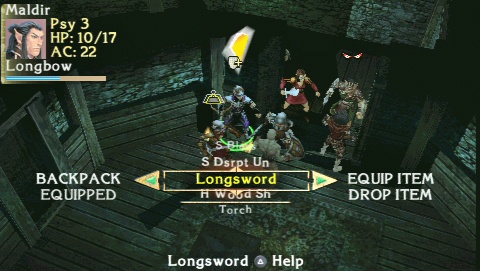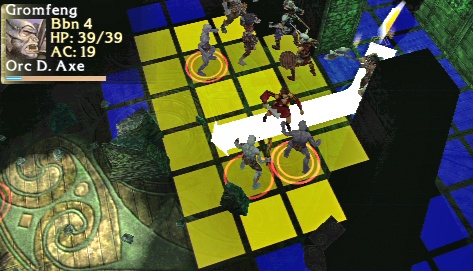Rarely is sorting through after-battle loot handled as poorly as it is in Dungeons & Dragons Tactics. While this PSP title from Kuju Entertainment is a mostly satisfying look at hardcore role playing, courtesy of slavish attention to D&D's version 3.5 rule set, a spectacularly awkward interface slows the action to a crawl both before and after the long swords come out. Venturing into the bowels of the earth to slay dragons and load up on gold pieces has rarely been so tedious.
Despite the title, D&D Tactics is actually a fairly straightforward turn-based RPG. The emphasis on tactical combat is only about as pronounced as you'd find in something like the old Gold Box games, which actually seems old-school appropriate for the debut of D&D on the PSP. Battles are the primary focus here, making the pace more measured than the standard contemporary RPG. But even though you need to have some appreciation for the 3.5 edition of the pen-and-paper D&D rules to truly enjoy this game, combat intricacies aren't too over-the-top. For the most part, you just need to have a reasonable idea of how to use each character class when it comes to melee and ranged fights, as well as some common sense when it comes to whipping out area-effect spells, such as a fireball. If you're a total newbie at this stuff, at least there are four opening tutorials to get you up to speed.

The only real difference between this game and a garden variety RPG is the predominance of set-piece missions with straightforward cleaning-house objectives. Instead of looking for the answers to some big mystery, you kill all of the goblins in a crypt, wipe out a bunch of thieves, or take on some similar style of methodical mayhem. While the role-playing depth isn't tremendous, there are loads of options. Full six-person adventuring parties are created from all of the D&D core classes, such as the mage, fighter, cleric, and rogue. There are also more esoteric selections, such as the barbarian and a pair of psionicists. You select which ones go on each assignment. All of the standard races are here as well: human, elf, dwarven, halfling, half-orc, and so on. Characters are fully detailed with all the expected skills and feats, whether you choose from the sizable pre-rolled crew or whip up your own. Their backgrounds even include such extras as god worshipped (nice to see St. Cuthbert again).
The game's story is a pretty ordinary fantasy tale. The lengthy solo campaign deals with the usual claptrap about arcane prophecies of doom, magical artifacts, and the end of the world. All events are also nicely illustrated with what look to be painted scenes that wouldn't have looked out of place on a panel van in the '70s. Most of it is driven by hack-and-slash dungeoneering although there are some choices to be made. The ethical "alignment" you choose for your characters--whether they have evil, neutral, good, lawful, or chaotic outlooks on life--is also a concern. It can be very tough to remain on the straight and narrow as a good guy; make a few bad choices as a noble paladin, and before you know it, your character's alignment has changed to evil.
That is, if you can get that far. All of the good aspects of D&D Tactics are sabotaged by major design flaws. Wrestling with the interface is the biggest headache. Although the two-part, turn-based movement and combat system is efficient when it comes to shifting your characters around the chessboard-like movement squares, as well as having-at-you in battle, everything features too many extra steps. You can't just push a single button and move, you need to push a button then scroll across a bunch of choices to select the move command. Same goes for attacking, casting spells, pulling items out of your backpack, resting, and so on, so that even the most common actions involve scrolling through at least three or four choices laid out in branching menus.
Sorting through items dropped by slain foes is even more irritating because you have to juggle the menus and deal with scant on-hand information on your new goodies. An extra four or five steps are needed just to find out if that cool new sword you've picked up is better than the shiny metal toothpick that you're currently wielding. And you have to go through this process every time you rob corpses because otherwise, your party ends up getting encumbered by all the weighty junk they have to carry around.
As a typical dungeon crawler, most of the action takes place in dark settings. This is great for atmosphere, especially when you've lit up a torch, but it's awful for control because it's impossible to see anything. Monsters often pop up out of nowhere. You're wandering through an empty crypt one moment, but the next moment, you'll be wondering: Where the hell did that pack of goblins came from? Worse, you can't rotate the camera back far enough to get a reasonable view of what's in front of you. It tilts some, but not nearly enough to see more than about 20 feet away from your characters, so you're stuck with what amounts to a top-down view on the action. This adds to the monster-pop-up irritation and makes it hard to explore dungeons because you never seem to get a good look at your surroundings. Making matters even more annoying is the camera's quick panning back and forth. When fighting long-range with bows or spells, it zips back and forth too fast for you to see exactly what's going on around you. For instance, if you summon a monster right at the feet of a baddie, the camera will snap back to you before it's even materialized, leaving you to wonder if the spell worked or not until you get around to your turn again. The speedy camera also makes it easy to miss a character getting knocked down to zero hit points and then bleeding to death.

Wireless multiplayer is supported, but it doesn't really add much to the game. You can't play cooperatively through the campaign, so your only options are monster bash and deathmatch. Both are pretty much mind-numbing killing sprees, although the former at least emphasizes teamwork. Its one big limitation is a paltry selection of just three maps (deathmatch fares a little better with five). Only the ability to switch character levels all the way from three to 15 adds any life to this mode of play.
Both visual and audio quality seem murky. Details on your characters and the monsters are so small that it's hard to tell who's who or what's what. The graphics are also afflicted with off-putting animations. Freshly killed foes kneel down like they're praying instead of collapsing like they've just shuffled off this mortal coil. Because this slumped-over posture doesn't vary much from standing up, it's tough to determine if an enemy is dead or not. All characters seem to make strange moves compared to what they're supposed to be doing. For example, opening a chest results in a triumphant leap into the air. Firing a crossbow looks like pitching a baseball. The animations are so far off that you often wonder if you've actually made the move that you intended. As far as audio goes, weapon clashes and bangs are tinny, while the choral music of the main score are so repetitive that you'll almost immediately mute the volume.
Faithfully re-creating its tabletop big brother is the sole positive aspect of D&D Tactics. And that's certainly commendable, especially if you're a nuts-and-bolts rules fan. With a better interface and some serious tweaks to the visuals, this one could have been a contender. But as it is, the game has too many design problems to enchant anyone aside from pen-and-paper diehards jonesing for D&D on the PSP.